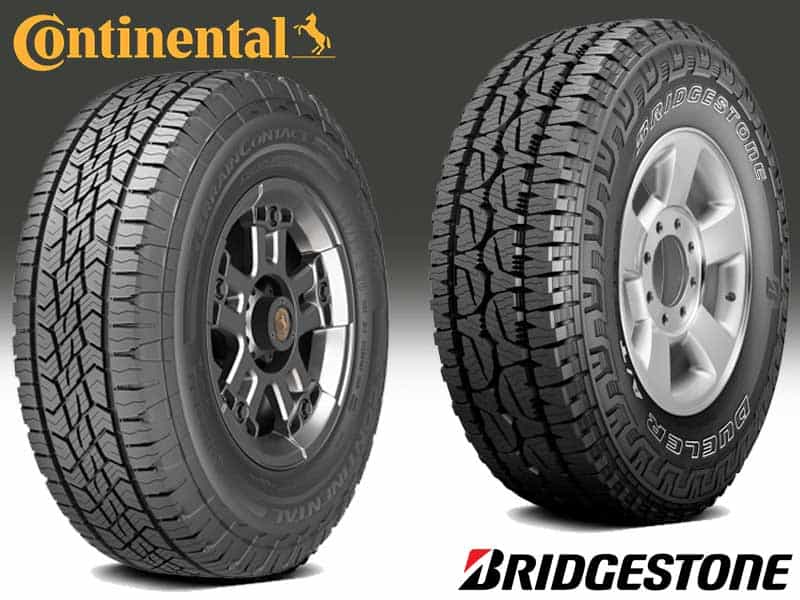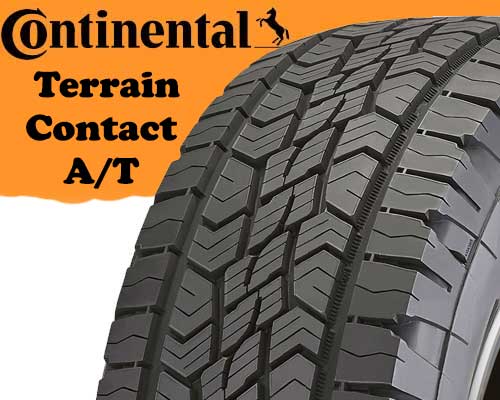These All-terrain tires promise to give you a smooth ride, all along, on any path, any road. Bridgestone Revo 3 flaunts its Traction Claw Technology that gives it an aggressive look. The ‘look’, after all, is what is going to take you through the difficult muddy, and snowy pathways. Isn’t it?
Continental Terrain retains its subtlety with a mild all-terrain design with an additive embedded in it. + Silane enhanced all-season compound is what is going to keep the grip of the tires on the difficult pathways strong.

How? Let’s ‘drive’ into it.
Table of Contents
Comparing Continental AT vs Bridgestone Revo 3
Continental TerrainContact A/T

Bridgestone Dueler AT Revo 3


Vs

So what’s behind the looks?
Continental TerrainContact A/T knows quite well how to prevent uneven wear for it holds stable tread blocks and a closed shoulder design. The full-depth sipes wipe away the water on the roads. And the edge-of-the-block traction grooves do not let the mud, water, or dirt on the path make your journey uncomfortable.
The symmetric pattern is quite a useful trait of the Bridgestone Dueler AT Revo 3 for that is what is going to prevent your tires from getting irregular wear. The strong shoulders and the stable tread blocks make the handling all good. Deep tread depths, wide grooves, and open shoulder slots are just what will the water away from the path of your vehicle. And while all of that happens, the sipes save the day by providing the right grip on the wet roads and on the snowy neighborhood.
Both the tires seem to have a very intelligent design for longer tread life, reduced wear, and dry and wet handling. However, the open shoulders of the Bridgestone Dueler AT Revo 3 are a plus when it comes to wet handling in comparison to the closed shoulders of the Continental Terrain Contact A/T.
Comparing the on-road traction
Roads can be dry or wet. And you gotta drive on the both.
Driving on a dry road
In the consumer survey stats, the dry traction offered by Continental Terrain Contact A/T was 9.2. This is well explained by the stable tread blocks and the closed shoulders that its design holds. The blocks offer the right amount of friction that keeps the vehicle stable as it moves, brakes or turns on a highway. Not only are the dry traction and the dry handling of the Continental Terrain Contact A/T great but the braking distance of the tire is also pretty less, which makes it a good option.
The strong shoulders and the stable tread blocks that the design of Bridgestone Revo flaunts offer increased friction between the road and the tire and hence increased stability. This makes the traction and the handling of the tire on a highway look great. However, in a road test, the braking distance of the Bridgestone Revo 3 tire was found to be a bit more than the Continental Terrain Contact A/T.
When it rains
When driving on a wet road, the deep sipes and the grooves on the Continental Terrain Contact A/T increase the contact between the road and tire by wiping away the water, mud, and dirt that comes on the way. This makes the traction on the wet roads, in particular, easy. That is why the wet traction of this tire has also been rated to be excellent and it has shown to have lesser braking distance.
Bridgestone Revo 3, along with its grooves and sipes, takes the help of its open shoulder slots that take the water out of way from the path of your vehicle. Although the tire still shows a slightly larger braking distance, its structure provides a stable drive while moving, braking, and turning on the wet roads.
Off Road Performance Comparison
You can’t expect the vehicle to run on smooth when it is running over some hard rocks or mud or just a lot of puddles. But you can expect to reach home safely.
When on rocks
Continental Terrain Contact A/T with its strong and stable tread blocks and the closed shoulders provides traction on the rocky surfaces. It will make your vehicle drive okay.
However, large rocks can be a problem.
When talking about Bridgestone Dueler AT Revo 3, we can’t forget about its Traction Claw Technology that churns the small rocks and dirt on the way making the drive much easier. That, combined with the stability of the tread blocks makes it look all good.
When on a soft path (mud or snow)
Continental Terrain Contact A/T has to face problems while driving through the mud because its sipes and the grooves are not deep enough to deal with it.
The 3D steps in the staggered shoulders of Bridgestone Revo 3 aid the tire in finding stability in the not-so-stable, soft pathways. The deep circumferential grooves make the drive in mud comparatively easier. However, while cornering on a snowy path, you might have to face problems.
Do they promise comfort?
The mild all-terrain tread pattern that Continental Terrain Contact flaunts gives the riders a comfortable smooth ride on road. It assures the driver of the stability of the vehicle on road. However, when taken off-road, the quality of your drive might deteriorate. As hard as it may be to drive on an irregular path, the smoothness of the ride may, quite frankly, vanish.
Revo 3, on the other hand, although provides the comfort the travelers and the drivers need, it has not been able to gain a rating as high as Continental Terrain A/T when it comes to driving on road. However, when it gets off-road, it seems to handle the irregularities a bit better, and hence does not take the comfort away completely.
What about Noise?
Continental tires in comparison to the other tires, produces much less noise on the road. It is almost inaudible. But as the speed is increased, it seems like it is a bit for the tire to take, and therefore you do begin to hear some noise.
On the other side, Revo 3 incorporates in its tires the Resonance Noise Attenuated silencer grooves, as a result of which, the noise produced by the tires is reduced to a great extent. However, the noise may get audible when you get on to the grooved surfaces.
Durability and treadwear
The closed shoulder designs and the stability of the tread blocks of the Continental Terrain Contact A/T provide the prevention of uneven wear and long tread life. How long, you may ask. Well, the company gives a 60000 miles warranty. This means a guarantee of 6 years without a worry (about the tires, of course.)
Not only does the symmetric pattern of Bridgestone Revo 3 provides safety from irregular wear, but there is something more that has been incorporated to increase the durability of the tire. The nylon reinforcement ply greatly increases the life and the durability of the tire!
This company, too, gives a 60000-mile warranty of the tire.
Which tire saves you more money?
Let us be honest. Good things are never cheap. Naturally, both these tires are expensive. However, Continental Terrain Contact A/T is known to be a bit more expensive than the other.
However, both these tires have a long tread life in comparison to the others. So this could be a good investment for a safer and more comfortable ride.
Which one to buy, then? – A Quick Summary
It really depends on your needs and wants. And a summary of what we just discussed might help you decide.
- Continental Terrain A/T’s strength lies in strong tread blocks and closed shoulders while Bridgestone Revo flaunts its open shoulders with a symmetric pattern.
- Continental Terrain A/T runs pretty well on dry roads but the quality of drive slightly deteriorates on the wet road. Revo 3 doesn’t fail to give a comfortable ride either. However, the braking distance is slightly more. It handles the wet roads well.
- Continental A/T might not be the best choice for someone who has to drive off-road too often. But Revo 3, with its deep sipes and claw technology, can perform okay off the road too.
- Both the tires can provide travelers with a comfortable ride on road. But Revo 3 provides a comparatively more comfortable ride off the road.
- Speaking of nosie. With Continental Terrain A/T, it tends to get audible at high speeds and with Bridgestone Revo 3, you may hear noise on the grooved surfaces.
- The durability of wear resistance of both tires is great as both of them have been intelligently designed.
- Continental tire here might cost you a bit more. But then again, it depends on the size of the tire you need and your traveling routine.


